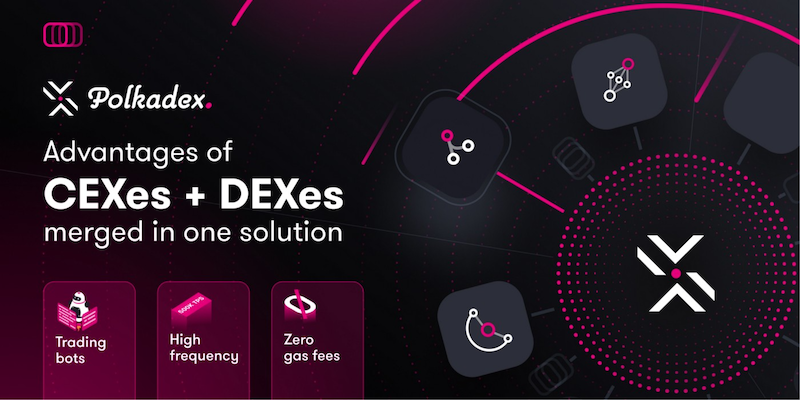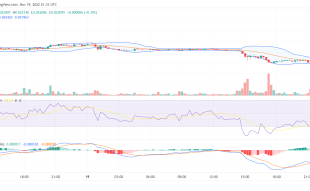Join Our Telegram channel to stay up to date on breaking news coverage
With the introduction of its new Orderbook, Polkadex hopes to set a standard for what is feasible with a DEX.
DeFi is full with brilliant concepts that can rebalance the dynamics of financial power. The implementation of these concepts in practical and sustainable ways has proven challenging thus far.
For example, the DEX, or decentralized exchange, is a key component of DeFi and a location where users may transact with one another without giving up control over their money or having to pay high fees. It appears perfect on paper. However, when you consider the main DEXes, they are not practical. High transaction costs, protracted wait times, a lack of network compatibility, and manipulation difficulties have all come to be associated with DEXes.
Enter Polkadex. In order to give users the best of both DEXes and CEXes, or centralized exchanges, Polkadex is launching the Polkadex Orderbook. The basic idea is that Orderbook customers can benefit from the convenience, speed, and security of a CEX without giving up ownership of their assets. However, like with other solutions to difficult issues, developing the Polkadex Orderbook was not straightforward. In order to learn more about the brand-new platform and how it plans to advance the whole DeFi business, Here ‘s how Polkadex CEO Gautham J. said in public.
When did you discover that the Orderbook needed to be started?
We have known for some time that CEXes and DEXes in their present form are not perfect solutions. Trading has always been more advantageous for CEXes. They have custody of the money belonging to their own users, nevertheless. The assets of users are at risk because of potential security concerns or even defaults when there is central control over funds.
While DEXes resolved the custody issue, they also brought up a whole new set of challenges for cryptocurrency traders, including decreased functionality, exorbitant network costs, serious issues with manipulation like front-running, and restricted liquidity and token access. A non-custodial orderbook DEX is essential, and the recent FTX catastrophe and the vulnerabilities it exposed to institutional and retail traders has only strengthened this requirement.
What issues is this platform meant to address?
The issue of centralized exchange operators needing to maintain custody of funds has been resolved. To do this, we created a non-custodial exchange that functions and feels just like a CEX. In other words, Polkadex combines the greatest aspects of CEXes and DEXes while excluding their drawbacks. The end product is an order book-based DEX that is scalable to high-frequency trading and is interoperable and simple to use. The interoperability of the platform is one of the features you have emphasized.
What makes that such a problem for other DEXes, and how comprehensive will Polkadex’s interoperability be?
DEXes are currently essentially isolated. The networks they use to operate essentially bind them. For instance, DEXes based on Ethereum can only trade Ethereum tokens. On the other hand, given to their centralized, off-chain structure, CEXes can accommodate a variety of networks and tokens.
We have invested in creating our own internal solution, the THEA protocol, to guarantee high liquidity and cross-chain interoperability. With the help of THEA, a state-of-the-art interoperability solution, Polkadex will be able to handle token trades on other blockchain networks, starting with Ethereum.
To support tokens from the Polkadot network and its parachains and get access to ecosystems like Polygon and Ripple, the THEA bridge will join with the Polkadex parachain. Polkadex Orderbook is now the first cross-chain, order-book-based trading platform that is not custodial.
Instead of using the AMM (automatic market maker) strategy made famous by DEXes, your exchange is based on a unique blockchain. What motivated you to use Polkadot, and why?
Automated market makers were a workaround rather than a permanent fix. Orderbook-based DEXes were difficult for programmers to create in a constrained setting like the blockchain.
The fact that centralized operators have custody of user assets is the problem’s fundamental cause, and that is all we need to address. If we can create an exchange that functions exactly like the CEX but without the operator having possession, then success! The answer is that, and we implemented it using Polkadex.
Polkadot’s parachain-based architecture enables Polkadex to access liquidity from throughout the whole ecosystem, which explains why. Furthermore, the Substrate framework is the only blockchain framework that enables Polkadex Orderbook since it enables us to adjust the Polkadex network’s parameters to the Layer 2 TEE. This is because of its highly flexible nature and forkless upgrades.
What sort of KYC requirements will your exchange’s users face?
Use of the Polkadex Orderbook is currently not subject to any KYC requirements. Users will need to be verified in order to use specific Orderbook features like fiat deposits and withdrawals whenever we add currency support. In order to create a non-centralized solution for traceability and tracking, we are also collaborating with decentralized identity management blockchains.
What do you think are the biggest problems that the DeFi sector as a whole is now facing?
Many of the initiatives in DeFi are essentially R&D teams; they are not concerned with finding effective solutions to real business challenges. If projects stop making copies of existing technology and start concentrating on real solutions, the DeFi industry will advance more quickly.
Related
- Polkadot co-founder, Gavin Wood, resigns as the CEO of Parity
- How can NFTs be used in DeFi
- How to Buy Polkadot Coin (DOT) – Invest with Low Fees Today
Join Our Telegram channel to stay up to date on breaking news coverage


